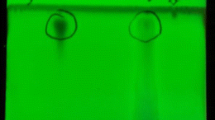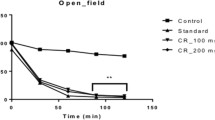Abstract
Ethanol extract of the of rhizome of Nymphaea alba, at graded doses was investigated for the central depressant activity of the ethanol extract of rhizome. The behavioral effect of the extract (75, 150 and 300 mg/kg) was evaluated using diazepam induced sleep test, hole-board test, beam walking assay, staircase test, open field test and elevated plus maze assay, all in mice. The findings of this study suggest that the extract of N. alba rhizome contains some bioactive principles that are sedative in nature.


Similar content being viewed by others
References
Abid M, Hrishikeshavan HJ, Asad M (2006) Pharmacological evaluation of Pachyrrhizus errosus (L.) Seeds for central nervous system depressant activity. Ind J Physiol Pharmacol 50:143–151
Adzu S, Amos S, Dzarma CW, Gamaniel K (2002) Effect of Zizypus spina christi wild aqueous extract on the central nervous system in mice. J Ethnopharmacol 79:13–16
Amos S, Kolawole E, Akah P, Wambebe C, Gamaniel K (2001) Behavioural effects of the aqueous extract of Guiera senegalensis in mice and rats. Phytomedicine 8:356–361
Bose A, Sahoo M, Dey Ray S (2012) In vivo evaluation of anti-diarrheal activity of the rhizome of Nymphaea alba (Nymphaeaceae). Orient Pharm Exp Med 12:129–134
Brown RE, Corey SC, Moore AK (1999) Differences in the measure of exploration and fear in mhc-congenic C57BL/6J and B6-H-2K Mice. Behav Genet 26:263–271
Castiella Ucelay E, Lasheras M, Frechilla D, Cenarruzabeitia D (1990) Neuropharmacological activity of Prunus spinosa stem extract in mice. Phytother Res 4:101–105
File SE (1973) Effects of chlorpromazine on exploration and habitation in the rat. Br J Pharmacol 49:303–310
Fujimori H (1965) Potentiation of barbital hypnosis as an evaluation method of central nervous system depressant. Psychopharmacol 7:374–397
Gilani AH, Rahman AU (2005) Trends in ethnopharmacology. J Ethnopharmacol 100:43–49
Grundmann O, Nakajima J, Seo S, Butterweck V (2007) Anti-anxiety effects of Apocynum venetum L. in the elevated plus maze test. J Ethnopharmacol 110:406–411
Hesham A, Abdel NB, Jari S, Kalevi P (2005) Hypolipidemic and antioxidant effect of Morus alba L (Egyptian mulberry) root bark fractions supplementation in cholesterol- fed rats. J Ethnopharmacol 78:2724–2733
Hogg S (1996) A review of the validity and variability of the elevated plus-maze as an animal model of anxiety. Pharmacol Biochem Behav 54:21–30
Jager AK, Saaby L (2011) Flavonoids and the CNS. Molecules 16:1471–1485
Johnston GAR (2005) GABAA receptor channel pharmacology. Curr Pharm Des 11:1867–1885
Kang TH, Oh HR, Jung SM, Ryu JH, Park MW, Park YK (2006) Enhancement of Neuroprotection of Mulberry leaves (Morus alba L.) prepared by the Anaerobic treatment against ischemic damage. Biol Pharm Bull 29:270–274. doi:10.1248/bpb.29.270
Keller WJ, Hatfield GM (1982) Gramodendrine, a bipiperidyl-indole alkaloid from Lupinus arbustus Subsp. Phytochemistry 21:1415–1417
Leporatti ML, Ivancheva S (2003) Preliminary comparative analysis of medicinal plants used in the traditional medicine of Bulgaria and Italy. J Ethnophamacol 87:123–142
Matsumura F (1985) Toxicology of insecticides, 2nd edn. Plenum Press, New York, p 588
Morais LCSL, Barbosa-Filho JM, Almeida RN (1998) Central depressant effects of reticuline extracted from Ocotea duckei in rats and mice. J Ethnopharmacol 62:57–61
Naghma K, Sarwat S (2005) Inhibition of potassium bromated induced renal oxidative stress and hyperproliferative response by Nymphaea alba in Wistar rats. J Enzym Inhib Med Chem 20:275–283
Perez GRM, Perez IJA, Garcia D, Sossa MH (1998) Neuropharmacological activity of Solanum nigrum fruit. J Ethnophramcol 62:43–48
Rabbani M, Sajjadi SE, Zarei HR (2003) Anxiolytic effects of Stachys landulifolia Vahl on the elevated plus-maze model of anxiety in mice. J Ethnopharmacol 89:271–276
Rakotonirina SV, Ngo Bum E, Rakotonirina A, Bopelet M (2001) Sedative properties of the decoction of the rhizome of Cyperus articularis. Fitoterapia 72:22–29
Robin D (2001) Nymphaea odorata: white pond lily. Medical herbalism. Mater Med Pharm 11:231–233
Rodgers RJ, Cao BJ, Dalvi A, Holmes A (1997) Animal models of anxiety: an ethological perspective. Braz J Med Bio Res 30:289–304
Rolland A, Fleurentain J, Lanhers M, Younos C, Misslin R, Morier F (1991) Behavioural effects of American traditional plant. Eschscholzia California: sedative and anxiolytic properties. Plant Med 57:212–216
Simiand J, Keane PE, Moore M (1984) The staircase test in mice: a simple and procedure for screening of anxiolytic agents. J Psychopharmacol (Berlin) 84:48–53
Sousa FCF, Leite CP, Melo CTV, Arauyo FLO, Gutierrez SJC, Barbosa-Filho JM, Fonteles MMF, Vascomcelos SMM, Barros Viana GS (2007) Evaluation of effects of N-2-(2-Hydroxybenzoyl) tyramine (riparin II) from Aniba riparia (NEES) MEZ (Lauraceae) in anxiety models in mice. Bio Pharm Bull 30:1212–1216
Stanley JL, Lincoln RJ, Brown TA, McDonald LM, Dawson GR, Reynolds DS (2005) The mouse beam walking assay offers more sensitivity over the rotarod in determining motor coordination deficits induced by benzodiazepines. Psychopharmacol 19:221–227
Starec M, Waitzov'a D, Elis J (1988) Evaluation of the analgesic effect of RG-tannin using the “hot plate” and “tail flick” method in mice. Cesk Farm 37:319–321
Treit D, Menard J, Royan C (1993) Anxiogenic stimuli in the elevated plus maze. Pharmacol Biochem Behav 44:463–469
Vergeera LH, Vander VG (1997) Phenolic content of daylight-exposed and shaded floating leaves of water lilies (Nymphaeaceae) in relation to infection by fungi. Oecologia 112:481–484
Vongtau HO, Abbah J, Ngazal IE, Kunle OF, Chindo BA, Otsapa PB, Gamaniel KS (2004) Antinociceptive and anti-inflammatory activities of the ethanolic extract of Pinanari polyandra stem bark in rats and mice. J Ethnopharmacol 90:115–121
Wei X, Yang J, Wang J, Wu C (2007) Anxiolytic effect of saponins from Panax quinquefolium in mice. J Ethnopharmacol 111:613–618
Wolfman C, Viola H, Paladini AC, Dajas D, Medina JH (1994) Possible anxiolytic effects of chrysin, a central benzodiazepine receptor ligand isolated from Passiflora coeruiea. Pharmacol Biochem Behav 47:1–4
Author information
Authors and Affiliations
Corresponding author
Rights and permissions
About this article
Cite this article
Bose, A., Ray, S.D. & Sahoo, M. Central depressant activity of ethanol extract of Nymphaea alba rhizome in mice. Orient Pharm Exp Med 13, 159–164 (2013). https://doi.org/10.1007/s13596-013-0108-4
Received:
Accepted:
Published:
Issue Date:
DOI: https://doi.org/10.1007/s13596-013-0108-4




